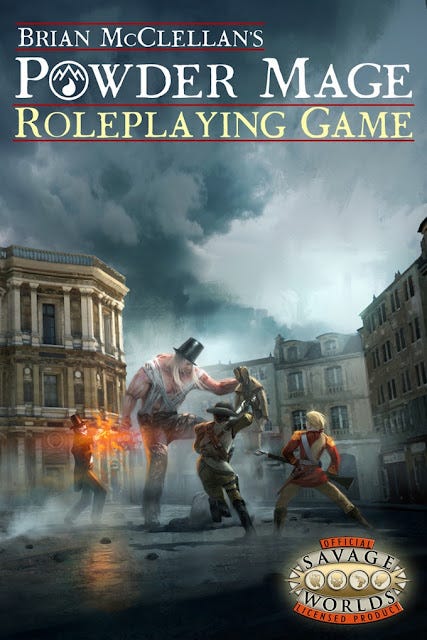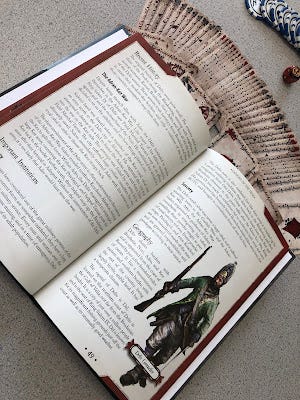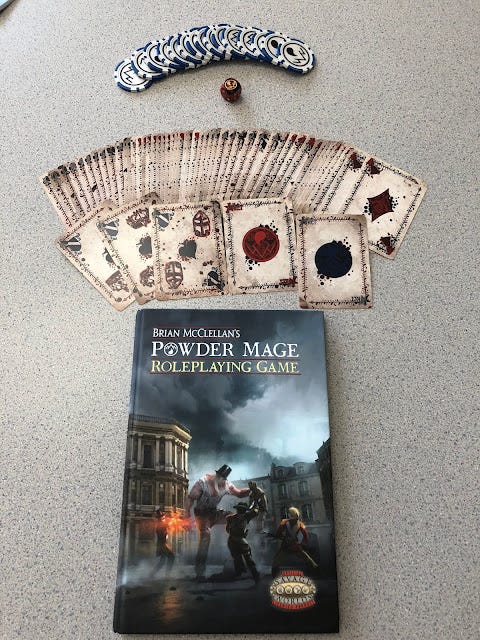Revolution and Magic
An Updated Review of Brian McClellan's POWDER MAGE Role Playing Game.
Ethan Sabatella mentioned that he wondered if Brian McClellan had considered making/basing a role playing game on the Powder Mage series of books and since I’ve reviewed the game in the past, I knew the answer to that question to be yes. I’m sharing an updated version of a review I posted here about a year and a half ago where I discuss the role playing game Alan Bahr designed based on McClellan’s excellent series of books.
Introduction
Given my love of step-die and other cool game mechanics, it probably comes as no surprise that I am a big fan of the Savage Worlds role playing game. It's an easy to learn and simple to play game that is remarkably flexible. This flexibility allows the Savage Worlds rules set to be used as the basis of games set in a wide range of genres. The system can handle everything from gritty low magic fantasy to cosmic powered super heroes without missing a beat. The characters from each campaign may not fit well in the other campaign due to scaling issues, but the mechanics work seamlessly in each setting.
I am also a fan of Brian McClellan's Powder Mage trilogy and was hooked from the first few pages of The Promise of Blood. McClellan manages in the trilogy, to achieve something that has become more rare in modern fantasy fiction. He is able to tell stories of "regular folk" in addition to the epic heroes at the center of the tale. Most modern tales focus on the movers and shakers and those who embody whatever magic system was invented for the series and rarely do they have “powerless” characters be among the most important and compelling in the saga. Every major character in Wheel of Time has a quirk, the vast majority of characters in the Stormlight Archive have a nahel bond of some sort or some other talent that sets them apart from the common person. That McClellan is able to democratize the fantasy tale, without deconstructing it as Rian Johnson did with Star Wars, is a testimony to his talent. He achieves fully what Rian Johnson wanted to achieve, even as he keeps the epic moments.
The “Gods” matter, the “Privileged” matter, the “Powder Mages” matter, but so too does the middle class investigator with a family. That middle class investigator might have a perfect memory, but when you’ve got opponents who can lay waste to a building with a wave of their hands that’s a pretty minor talent.
From a role playing game point of view The Powder Mage trilogy alternates point of view characters between characters at vastly different power levels, but the lower powered characters are as important to the resolution of the conflict as the most powerful characters. It is one of the most impressive things about this inventive series, and it is something that makes it perfect for the Savage Worlds system.
Some Background to the Making of…
Brian McClellan’s Powder Mage Role Playing Game was launched and funded on Kickstarter in 2016 and designed by Alan Bahr of Gallant Knight Games. At the time, Alan was a relatively new game designer. He had designed the Planet Mercenary game for the Schlock Mercenary comic in 2015 and I got to be his friend because of discussions I had with him around that time. Not because I was a backer or fan of Schlock Mercenary, neither were true, but because I saw a lot of the envy driven in tabletop social media saying “Just who does Alan Bahr think he is that he gets to design a game for Schlock Mercenary? What are his prior credits?” I thought the commentators were wildly off base, and really just displaying that they were envious and angry, and so reached out to Alan to chat.
What I discovered after my first couple of chats with Alan was that he was a guy filled with gaming ideas, lots of gaming ideas. He may not have had a lot of published works, but he had been a gamer for a long time and had done something that most of the envy mongers had never done. He had tons of drafts of games he’d designed and not published. I became an instant fan and have backed several of Alan’s gaming designs since and am one of his biggest proponents. He is one of the nicest people in gaming and has some really great design intuitions. He’s currently working with James M. Spahn to publish the White Box Cyclopedia. In this case, Alan is bringing his now significant publishing experience to table. As you know, I don’t do “Top 10” lists, but if I did Alan Bahr would easily be in my Top 10 game designers.
Alan Bahr’s design of Brian McClellan’s Powder Mage roleplaying game is one of his earlier game design efforts, but in it you can see the raw design talent he brings to the table. In part because The Powder Mage Trilogy presents a pretty interesting challenge for the game designer, a challenge also presented by Monolith’s Batman Chronicles role playing game…but my review of that won’t be until next week.
The Powder Mage's Challenge to Game Design
Before I get too deep into a review of Brian McClellan's role playing game adaptation (the print version is out of print, but the pdf is available), I'd like to take a moment to discuss the particular challenge anyone adapting The Powder Mage trilogy into a game faces due to the varying power levels in the tales. As I mentioned above, McClellan has characters in his book that operate on at least three levels of power. I would classify these tiers in the following way.
1) "Normal" Skilled Characters.
2) Experienced Characters with Minor Boon/Ability.
3) Characters with Extraordinary Powers. (Gifted Mages, Powder Mages)
4) Characters with Extraordinary Powers at Super Heroic Levels. (Predeii)
5) Gods.
With the exception of the God tier, more on that later, there are characters of deep narrative importance at every tier. In other words, there are characters I would classify as Player Character worthy at each of these tiers and McClellan does a great job of balancing them narratively. In this particular case it is this very dilemma that makes Savage Worlds the perfect system for adapting the books.
At the first tier of power are characters like SouSmith and Ricard Tumblar. SouSmith is a boxer who gets hired as a bodyguard for someone at tier 2 and Tumblar is one of the most politically powerful characters in the world. These would be standard characters in a picaresque low-magic fantasy campaign or a game without any magic at all.
Adamat and Sergeant (later higher rank) Olem are paragons of the tier two characters. Experience wise, and skill wise, these characters are similar to tier 1, but they have something that sets them apart called a knack. For Adamat it's a perfect memory and for Olem it's the fact that he doesn't need to sleep. These characters can also use their "third eye" to see magic. Most of the "knacked" of the books are at tier 2, but there are some who are higher.
Tier's 1 and 2 are the low fantasy tiers and tier 3 is where you really begin to see people separate in power. All "privileged" mages and many Powder Mages fall into this group. There are some Powder Mages at tier 2 and some at tier 4 to 5, but most are in the mid-tier 3 range. These are characters who have the same number of skills as other characters, but who also possess magic abilities that allow them to destroy buildings with the wave of a hand. I initially wondered whether Savage Worlds' basic magic system could emulate "privileged" mages, but after comparing the dice of damage from a Cannon firing Solid Shot (3d6+1 Heavy Weapon per page 77 of the Savage Worlds Adventure Edition) with that of Burst (3d6 and HW with proper power point expenditure) and Blast (2d6 or 3d6 and HW with modifier), those concerns went away. With the damage modifier the Burst spell has destructive power slightly less than a modern 20mm cannon (4d6 vs 2d12) and Blast has slightly less power than a medieval cannon. While neither is going to tear apart a modern Abrams tank, they both will make quick work of a Jeep or more importantly a medieval building. There are a number of characters at this level of power in the book.
Tier 4 characters are like tier 3 characters on steroids. Where a standard "privileged" mage can make short work of the façade of a house, a "predeii" can lay waste to the entire building and bullets bounce of their skin without the aid of a magic shield. Similarly, the Powder Mage Taniel can withstand the assaults of a predeii and amplify his strength and agility to levels beyond that of mere mortals.
The Gods themselves come in at tier 5. I won't go into detail about the Gods of The Powder Mage trilogy, but I will say that they are a key focus of the conflicts in the books and that they are not so far removed from tier 4 as to make them uninteresting. Whether some other characters fall in at tier 5 I'll leave for you to discover.
The Powder Mage Roleplaying Game as Sourcebook
One of the things that becomes immediately clear as one reads Brian McClellan's Powder Mage Roleplaying Game is that the author himself has written much of the content. As a sourcebook discussing the history of the world and giving you a rich sense of place in order to set your games, this book is invaluable. Based on this content alone, I would recommend this book as a purchase for gamers and non-gamers who are fans of the series. McClellan's presentation of the setting is as readable as the fiction and the team has selected some excellent artists to capture The Powder Mage setting. If you want to know the state of the world after The Powder Mage trilogy, then this is the place for you.
But How is It as a Game?
TL;DR — I want a Powder Mage Setting GM Guide.
If there is any place where Powder Mage lags behind, it is as a role playing game book. While the lore is all there to inspire play, there are mechanics that still need to be flushed out to fulfill the promise of the setting. Alan Bahr, who is a very good designer and who is on an absolute tear when it comes to putting out good books and has learned a lot since this early game, could have done a bit more here. While he does provide some of the new rules one expects in a Savage Worlds rpg setting, new Background Edges for example, there are some weaknesses in these examples and some major holes in the book if you want to get the full Powder Mage experience. Those holes can be filled with the use of the Savage Worlds Fantasy and Super Powers Companions, but do require some work on the part of the game master.
After a very strong beginning, a discussion of the goals of good gaming and fitting the tone to match the desires of your players, the character creation chapter begins to peter out in the background edges section as it tries to adapt the Powder Mage archetype to the Savage Worlds rules. In doing so it attempted to create a new subsystem rather than fit the archetype within the existing subsystems Savage Worlds had to offer.
In this particular case, the character reads more like the Gunslinger from Pathfinder/Critical Role and less like a Powder Mage. Bahr and McClellan might have been better served to use the Super Powers Companion or see how the standard magic system fit with the archetype. This is what I did when I ran the game. Given the power tiers above, most Powder Mages are easily represented by the standard magic system with some additions from the Fantasy Companion and that outliers like Taniel were better represented using the Super Powers Companion. I didn’t bring in any of the extremely powerful predeii or the “Gods” but the Super Powers Companion could handle those easily.
That is a mere disagreement of design, and is a minor one at that. Bahr and McClellan's point system for Powder Mages does work, and well, even if it's not how I would do it.
The game is extremely useful as the book is for players and book fans, having rules for character creation and a detailed gazetteer, but it isn't as useful as it needs to be for game masters. One of the things that Savage Worlds game masters have been spoiled by is how the game's Fast, Furious, and Fun mantra has influenced how useful the books are to GMs with only small windows of prep time. Pick up any official Savage Worlds world book and you'll find quick and dirty adventure generators, a short adventure made of linked events, and enough NPCs to make a short campaign. This is what Brian McClellan's Powder Mage Roleplaying Game lacks.
While the game does include a couple of very fun, and easy to start a campaign, short adventures, it lacks a bestiary or the quick and dirty adventure generators one would find in The Goon, Necessary Evil, 50 Fathoms, etc. The rule book lacks statistics for "Wardens" of either the standard or "black powder" variety. Given how ubiquitous Wardens are as opponents in the books, and the fact that there is a Warden on the cover of the role playing game, this is significant. If you are wondering who the big fellow with the stove pipe cap on the cover is, that’s a Warden.
Of course, these flaws could easily be solved with a campaign/adventure supplement that I’d happily buy because this setting is ideal for a game campaign. Of course, if you’ve read the books and are a Savage Worlds fan, you can build these very easily, but they wouldn’t be “official.”
Really what I’m saying here is that Brian McClellan’s Powder Mage Role Playing Game is a solid foundation for a game and that it’s biggest flaw is that I want more of it. That may be a criticism, but it’s not a negative one. If a reader’s biggest complaint is “please sell me another book so I can run this for a long term campaign,” which is the case here, then it’s not really a complaint. After all, Champions barely had any example characters when it first came out and AD&D had its background material, monsters, player material, and dungeon master materials all in separate books.
Final Assessment
TL;DR — BUY IT.
Though I think there is room for improvement in the product, I highly recommend this book. For the setting material alone, this book is well worth the price of the pdf. What this book needs is a couple of pdf supplements written just for GMs. They don't have to be long and could be limited to a bestiary and adventure generator, but they would really fill out the holes in the initial release. It's 85% of were it needs to be as a “single book” game and 110% of where it needs to be as a sourcebook and I’m happy to have it in my gaming library.









